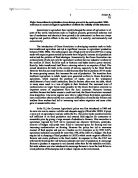In the EU, the Common Agricultural policy was first introduced in 1960 and its main aim was to ensure a reliable and adequate supply of food after WWII. It plays a main role on agricultural land use within the EU. The policy made countries become self sufficient in its food production and ensured food supplies for consumers at reasonable price by giving a large amount of subsidies to farmers. This innovation in agriculture imposed by CAP led to increased use chemical fertilizers, pesticides, removal of hedges and ponds were filled to increased space for farming and also increasing mechanization on farming. However the policy has led to enormous amount of food surplus and put on a burden on EU taxpayers as by 1970 CAP’s agricultural subsidies accounted for more than 75% of the entire EU budget. The food surplus led to dumping of food products in LEDCs which create negative effects for farmers and create problems in the food market. In response to this, the CAP was reformed by breaking the link between subsides and level of production to encourage farmers to produce in response to real demand rather than for the subsidies available. Set-aside scheme was also introduced to encourage farmers to leave the land fallow to avoid problems of food surplus and to reduce impacts on the environment.
Moreover, innovations in agriculture also result from irrigation schemes that allow crops to be grown where the natural environments do not support it. One major irrigation project in the Aral Sea proves to be rather controversial. The main aim was to make the USSR becomes self sufficient at cotton production and grow cotton plants in the areas around the Aral Sea by irrigating water from the two rivers that feed into the Aral Sea. As a result, the USSR became self sufficient at cotton production and fully utilized the area that once nothing grew before. However, the scheme has produced significant environmental problems. The Aral Sea shrunk in size as less water is left to feed it and problems of salinisation occurs and water supply became contaminated for people to use. The fishing industry also suffers.
Farming has also became more capital intensive on both LEDCs and MEDCs due to investment from multinationals like Tesco and Unilever’s rubber plantations in Cameroon. In LEDCs, the growth of agribusiness has led to increased food production and increased the GDP of the country as the country becomes more productive and increased its export level. The investment from transnational companies have helped to create positive multiplier effect and improved the living standard of the many LEDCs like Thailand and Malaysia with its extensive rubber plantations. However, the nature of capital intensive farm is to maximize production. This has led to increasing use of pesticides such as DDT have eliminated pest and increased production but at the same time the chemicals contaminate the environment and accumulate in the food chain known as bioaccumulation. The use of fertilizers increases the level of nutrients and increases yields but also creates negative environmental impact as some nitrates leak out and causes problems of euthrophication. The increased use of chemicals also contaminate water supply in the area and affected the local people in the area and the aquatic lives living there.
However, the recent demand and changing trends towards healthier food is shifting the nature of farming. The increasing demand for organic goods has led to the growth of organic farming in many parts of the world especially in MEDCs. Organic farming can be considered as a method of sustainable farming as produces food but also conserves the environment as it excludes the use of chemicals but instead use biological control and organic fertilizers such as manure instead. Some may argue that organic farming is not sustainable as farms are not likely to make much profit as it involves high cost and farms cannot take advantage of economies of scale due to its low level of production. Most importantly, organic farming cannot satisfy the increasing demand in food as well as commercial farming.
The latest innovation in agriculture and the one that generated most public discussion seems to be the appearance of genetically modified food crops in the market. Genetically modified foods are a result of DNA technology which manipulates the genetic combinants of crops by inserting genes of other crops or organisms into the original crop o create new advantageous characteristics. Genetic modifications offer a way to quickly improve crop characteristics such as yield, pest resistance, or herbicide tolerance, often to a degree not possible with traditional methods. However, the power of genetic modification techniques raises the possibility of human health, environmental, and economic problems, including unanticipated allergic responses to novel substances in foods, the spread of pest resistance or herbicide tolerance to wild plants, inadvertent toxicity to benign wildlife, and also increasing control of agriculture by biotechnology corporations. Moreover, GM foods is a very controversial issue especially because we do not know the full extent of the problems and benefits of it and some argue that the creation of GM foods is messing with nature and go against religious beliefs.
To certain extent, innovations in agriculture such as the Green Revolution and the Common Agricultural policy have proved to be commercially and socially successful at first but they are not commercially and socially sustainable and definitely not environmentally sustainable. For instance, the Green Revolution helped to increase yields and production but increase the burden on farmers for purchasing HYVs seeds. The Green Revolution did not succeed in making India totally and permanently self- sufficient in food. Due to poor monsoon, India had to import onions in 1998. As for the CAP, the policy has produced too much surplus and created burden on tax payers. The schemes have also been reforming and can be said that the policy is trying to restore the modern day land use back to the traditional agricultural land use. However, these innovations don’t prove to be sustainable for long term as they produce negative socio-economic effects and extensively damages the environment. However, some may argue that in today's globalised economic scenario, 100 per cent self-sufficiency is not considered as vital a target as it was when the world political climate was more dangerous due to the Cold War. Moreover, commercial farming whether they are in MEDCs and LEDCs there is always positive effects and negative effects. But it is questionable whether the positive outcomes outweigh the negative effects. In the short term, the countries would benefit from commercial farming but the environmental effects such as soil exhaustion and over cultivation are long lasting. Technological innovations in agriculture such as GM foods could help to answer the problems of food shortages and allow crops to be resistant to surrounding environment but at the same time we do not know the negative consequences that it can cause. To a certain extent, it seems that none of the innovations are completely socially, commercially and environmentally sustainable and it is obvious that major innovations in agriculture have proved to be controversial







